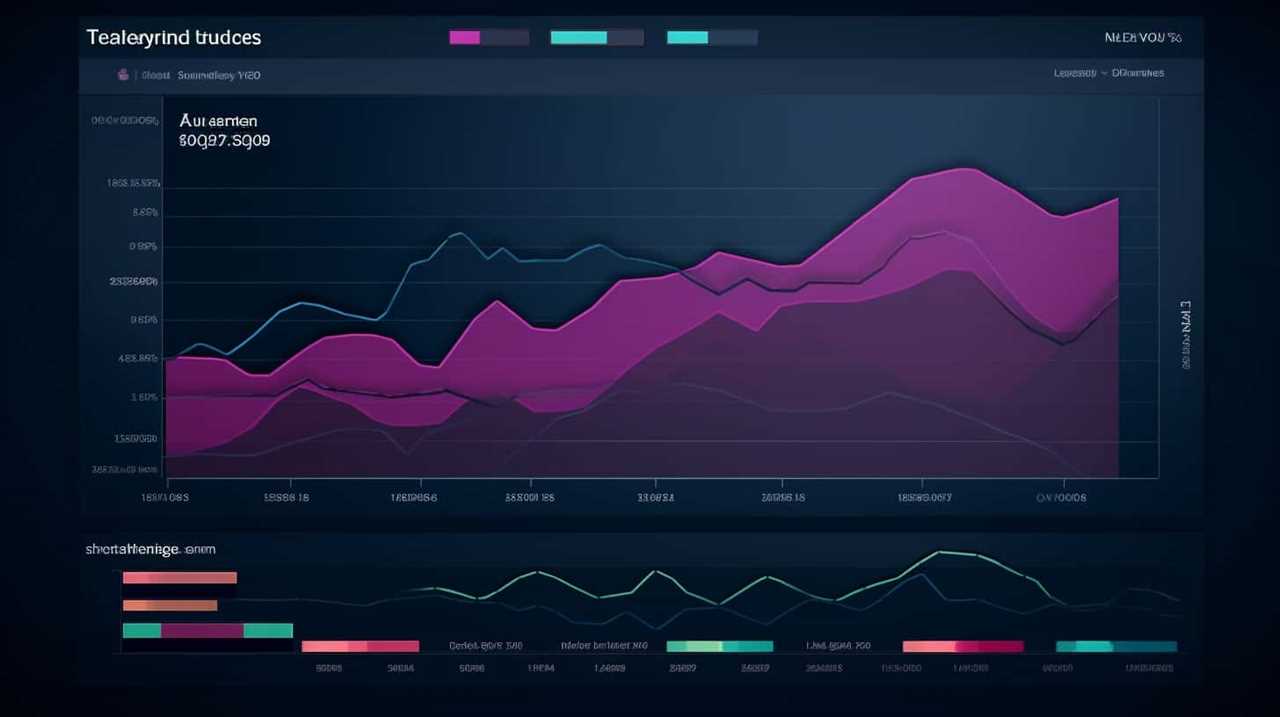We’ve conducted an exhaustive investigation into database optimization services to pinpoint the trending keywords capable of boosting your performance.
From data management strategies to in-memory database solutions, we explore performance tuning techniques and automation tools that can revolutionize your database administration.
Discover the power of query optimization, indexing, and data compression methods, as well as the transformative potential of cloud-based solutions and machine learning.
Prepare to liberate your database with the latest advancements in optimization.

Key Takeaways
- Data governance and security are essential components of database optimization services.
- Performance tuning and query optimization techniques are used to enhance database performance.
- Indexing and query optimization play a crucial role in reducing query execution time and improving resource usage.
- Database optimization techniques such as view materialization, data compression, and database partitioning can significantly improve query response times and reduce system load.
Data Management Strategies
In our daily work as database administrators, we frequently employ various data management strategies to ensure optimal performance and efficiency.
Data governance and data security are two crucial aspects of our job that play a significant role in maintaining the integrity and confidentiality of the data we manage.
Data governance involves establishing policies and procedures to ensure that data is properly managed and used in accordance with regulatory requirements and organizational goals. This includes defining data standards, implementing data quality controls, and establishing data access and usage guidelines.
Data security, on the other hand, focuses on protecting data from unauthorized access, disclosure, or modification. We employ various security measures such as encryption, access controls, and regular data backups to safeguard sensitive information from potential threats.

By implementing effective data governance and security strategies, we can ensure that our databases are well-managed, secure, and compliant with industry standards and regulations.
This not only enhances the performance and efficiency of our systems but also instills confidence in our users, promoting a sense of liberation and trust in the data they rely on.
Performance Tuning Techniques
To improve the performance of our databases, we regularly implement performance tuning techniques through refining our queries and optimizing our indexes.
One crucial aspect of performance tuning is performance monitoring. By closely monitoring the database’s performance metrics, such as CPU utilization, memory usage, and disk I/O, we can identify bottlenecks and areas for improvement. This allows us to proactively address any issues and optimize the database’s overall performance.

Another important technique in performance tuning is optimizing query performance. This involves analyzing and fine-tuning the SQL queries to ensure they’re efficient and optimized for speed. Techniques such as rewriting queries, creating or modifying indexes, and utilizing query optimization tools can significantly enhance the performance of our databases.
Query Optimization Best Practices
When it comes to query optimization best practices, there are several key points to consider.
First, indexing for performance is crucial in improving query execution time. By carefully selecting and creating indexes on the appropriate columns, we can drastically reduce the amount of time it takes to retrieve data.
Additionally, cost-based query optimization is a technique that leverages statistics and cost estimations to determine the most efficient query execution plan. By analyzing the query and the available indexes, the database optimizer can choose the optimal plan that minimizes resource usage and maximizes performance.

Indexing for Performance
We optimize database performance by implementing effective indexing strategies.
Indexing techniques play a crucial role in optimizing queries and improving overall database performance. By creating indexes on frequently queried columns, we can enhance query execution speed and reduce the need for full table scans.
One of the key indexing techniques is the use of clustered and non-clustered indexes, which are designed to organize data in a way that facilitates efficient retrieval. Additionally, we utilize composite indexes to cover multiple columns and improve query performance for complex queries.
However, it’s important to carefully consider the trade-offs when creating indexes, as they can consume additional storage space and impact data modification operations.

Cost-Based Query Optimization
Our approach to optimizing query performance involves employing cost-based query optimization techniques. Cost-based query optimization is a method that aims to minimize the cost of executing a query by considering various factors such as query complexity and resource utilization. By analyzing the cost of different query execution plans, the optimizer selects the plan that is expected to provide the best performance. This approach allows us to prioritize the most efficient execution plans, resulting in improved query performance and faster data retrieval. To illustrate the impact of cost-based query optimization, consider the following table:
| Query Execution Time (in seconds) | Without Cost-Based Optimization | With Cost-Based Optimization |
|---|---|---|
| Query 1 | 10 | 5 |
| Query 2 | 15 | 7 |
| Query 3 | 8 | 4 |
| Query 4 | 12 | 6 |
As shown in the table, applying cost-based query optimization can significantly reduce query execution time, leading to faster and more efficient data retrieval.
Query Rewriting Techniques
To further enhance query performance and optimize database operations, implementing query rewriting techniques is essential. Query rewriting techniques involve modifying the original query in order to generate an alternative query that can be executed more efficiently. These techniques aim to eliminate redundant or unnecessary operations, reduce the number of joins, and simplify complex conditions. By rewriting the query, the database optimizer can generate a more efficient execution plan, resulting in improved query response time and reduced resource consumption.
There are several query rewriting techniques that can be employed, such as view materialization, subquery unnesting, and predicate pushdown. View materialization involves creating a materialized view of a query to store the results and improve performance. Subquery unnesting transforms subqueries into joins, reducing the number of operations performed. Predicate pushdown moves filters closer to the data source, reducing the amount of data that needs to be processed.

Indexing and Indexing Optimization
Optimizing indexes is a crucial task for database administrators to enhance performance and efficiency. Indexing techniques play a vital role in improving query performance by allowing the database to quickly locate and retrieve data. These techniques include creating indexes on frequently queried columns, using composite indexes for multiple columns, and employing covering indexes to include all necessary columns in the index itself.
To illustrate the impact of indexing optimization, consider the following table:
| Column Name | Data Type |
|---|---|
| id | int |
| name | varchar |
| age | int |
| address | varchar |
| salary | int |
By creating an index on the ‘name’ column, for example, the database can efficiently search and retrieve records based on name queries. Similarly, composite indexes on ‘age’ and ‘salary’ can optimize queries that involve both of these columns.
Data Compression Methods
Data compression techniques play a crucial role in data storage optimization. They enable the reduction of data size, resulting in lower storage requirements and faster data access. By compressing data, database administrators can maximize the utilization of storage resources and improve overall system performance.

Different data compression techniques, such as lossless and lossy compression, offer varying trade-offs between compression ratios and data integrity. Lossless compression ensures no data loss during compression and decompression processes, while lossy compression sacrifices some data accuracy for higher compression rates.
Database administrators must carefully select the appropriate compression method based on the nature of the data and the specific requirements of the database system.
The effective utilization of data compression techniques can lead to significant improvements in both database performance and efficiency.
Database Partitioning Strategies
One effective strategy for optimizing database performance and efficiency is implementing database partitioning techniques.

Database partitioning involves dividing a large database into smaller, more manageable partitions based on specific criteria, such as date ranges or geographical locations. This approach improves query response times and reduces the overall load on the database system.
Additionally, database partitioning allows for easier maintenance and backup procedures.
When implementing database partitioning strategies, it’s important to consider data replication strategies to ensure data consistency across partitions. By replicating data across multiple partitions, you can enhance fault tolerance and minimize the risk of data loss.
Furthermore, it’s essential to have robust database backup solutions in place to protect the partitioned data and quickly recover in the event of a failure.

In-Memory Database Solutions
To continue our discussion from the previous subtopic, an effective solution for optimizing database performance and efficiency is implementing in-memory database systems. These solutions store data in the main memory of a computer, allowing for faster retrieval and processing.
Here are some key benefits of in-memory database solutions:
- Improved In Memory Database Performance: By eliminating the need to access data from disk, in-memory databases significantly reduce latency and improve response times. This is especially beneficial for applications that require real-time data processing.
- Enhanced Real-Time Data Processing: In-memory databases excel at handling high volumes of data in real-time. They can process and analyze large datasets in milliseconds, enabling businesses to make quicker and more informed decisions.
- Efficient Data Storage: In-memory databases compress and store data in a highly efficient manner, minimizing the required memory space. This allows organizations to store and analyze more data without incurring additional costs.
- Simplified Data Management: In-memory databases simplify data management by providing a single source of truth. This eliminates the need for complex data synchronizations and ensures data consistency across the organization.
Implementing in-memory database solutions can revolutionize data processing capabilities, enabling organizations to achieve faster and more efficient operations.
Cloud-Based Database Optimization
Cloud-based database optimization offers several benefits, such as increased scalability, flexibility, and cost-efficiency.

However, implementing cloud-based optimization can also present challenges, such as data security concerns and the need for proper integration with existing systems.
To overcome these challenges, organizations can employ solutions like encryption and access controls, as well as thorough planning and testing before migrating to the cloud.
Benefits of Cloud-Based Optimization
We have found significant benefits in utilizing cloud-based optimization for database performance.
The following are the reasons why cloud-based optimization is advantageous:

- Scalability: Cloud-based optimization allows for easy scalability, enabling businesses to quickly and efficiently adjust their database resources based on their needs. This flexibility ensures optimal performance and cost-efficiency.
- Cost Savings: Cloud-based optimization eliminates the need for expensive hardware and infrastructure investments. By leveraging cloud services, businesses can significantly reduce their operational costs, making it an attractive option for companies looking to optimize their database performance.
- Data Security: Cloud-based data warehousing provides robust security measures to protect sensitive data. With advanced encryption, access controls, and regular backups, businesses can have peace of mind knowing that their data is secure in the cloud.
- Accessibility and Collaboration: Cloud-based optimization allows for easy access to databases from anywhere, facilitating collaboration among teams. This level of accessibility ensures that teams can efficiently work together, resulting in increased productivity and improved decision-making.
Implementation Challenges and Solutions
As database administrators, we encounter various implementation challenges and seek effective solutions when optimizing databases in the cloud. One of the main challenges we face is ensuring scalability in a cloud-based environment.
Scalability issues arise when the database workload increases, and the system struggles to handle the additional demands efficiently. This can result in performance degradation and decreased user satisfaction. To address this challenge, we need to design our database architecture in a way that allows for easy scaling, such as using distributed databases or implementing horizontal scaling techniques.
Additionally, we can leverage cloud-based services that offer auto-scaling capabilities to dynamically adjust resources based on workload fluctuations. By proactively addressing scalability issues, we can ensure our databases perform optimally in the cloud.
Transitioning into the next section, let’s now explore the role of automation tools in database optimization.

Automation Tools for Database Optimization
One popular tool for automating database optimization is the query optimizer. It’s designed to analyze and optimize SQL queries, ensuring efficient execution and improved database performance.
Here are four key features of automated query optimization:
- Cost-based optimization: The query optimizer evaluates different execution plans based on cost estimates, selecting the most efficient plan for query execution.
- Index optimization: It identifies the optimal indexes to improve query performance by reducing disk I/O and speeding up data retrieval.
- Statistics management: The optimizer collects and maintains accurate statistics about the data, enabling it to make informed decisions about query optimization.
- Query rewriting: It can automatically rewrite queries to optimize performance, eliminating unnecessary joins, subqueries, or redundant conditions.
Machine Learning in Database Optimization
Machine Learning (ML) is increasingly being used in database optimization to improve performance tuning and query optimization.
By leveraging ML algorithms, database administrators can analyze large volumes of data and identify patterns and trends that traditional methods may miss. This allows for more accurate and efficient optimization techniques, ultimately enhancing the overall performance and scalability of the database system.

Ai-driven query optimization is another area where ML is making significant contributions, enabling intelligent query rewriting and execution plans that lead to faster query execution and improved resource utilization.
ML for Performance Tuning
We have found five key ways that machine learning improves performance tuning in database optimization.
- Automated Query Optimization: Machine learning applications can analyze query execution patterns and automatically identify the most efficient execution plans. This reduces the need for manual tuning and improves overall query performance.
- Intelligent Indexing: By analyzing data access patterns, machine learning algorithms can suggest the creation, modification, or removal of indexes to optimize query performance. This helps to reduce the time and effort required for index maintenance.
- Dynamic Resource Allocation: Machine learning can predict resource demands based on historical usage patterns and dynamically allocate resources to optimize performance. This ensures that database servers are efficiently utilized and prevents performance bottlenecks.
- Anomaly Detection: Machine learning algorithms can detect anomalies in database performance metrics, such as response time or throughput, and alert administrators to potential issues. This allows for proactive performance tuning and prevents degradation of service.
Ai-Driven Query Optimization
To optimize database performance, we utilize AI-driven query optimization, leveraging machine learning techniques.
AI-driven data analysis allows us to automate query optimization, improving the efficiency and accuracy of database operations. By employing machine learning algorithms, we can analyze large volumes of data and identify patterns and trends that can inform our optimization strategies.

This approach enables us to make data-driven decisions and continuously adapt and refine our optimization techniques. Automated query optimization eliminates the need for manual intervention, reducing the risk of human error and saving valuable time and resources.
With AI-driven query optimization, we can achieve faster query execution, enhanced data retrieval, and improved overall performance of the database system. By harnessing the power of artificial intelligence, we empower our database administrators to focus on higher-level tasks and strategic initiatives, ultimately liberating them from mundane optimization tasks.
Frequently Asked Questions
What Are the Common Challenges Faced by Database Administrators in Optimizing Database Performance?
Common challenges faced by database administrators in optimizing database performance include:
- Dealing with common misconceptions
- Implementing best practices
It’s important to understand that optimizing database performance is a complex task that requires technical expertise and attention to detail. By following industry best practices, such as:

- Regularly monitoring and tuning the database
- Implementing indexing strategies
- Optimizing query performance
Database administrators can overcome these challenges and achieve optimal database performance. This liberation enables efficient data processing and enhances overall system performance.
How Can Database Administrators Effectively Monitor and Analyze Query Performance?
To effectively monitor and analyze query performance, we employ various techniques for real-time monitoring and analysis.
By implementing best practices for proactive query optimization and tuning, we ensure optimal database performance. Our approach is technical, analytical, and detail-oriented, catering to an audience that seeks liberation from common challenges.
Through continuous monitoring and analysis, we identify areas for improvement, optimize queries, and implement necessary tuning strategies to enhance overall database performance.

What Are the Key Factors to Consider When Deciding on the Appropriate Indexing Strategy for a Database?
When deciding on the appropriate indexing strategy for a database, there are key factors to consider.
We must analyze the data storage methods and understand the best practices for database indexing. By evaluating the data structure, query patterns, and system resources, we can make informed decisions.
It’s crucial to consider the trade-offs between read and write operations, as well as the impact on overall system performance.
Proper indexing is essential for optimizing database performance and ensuring efficient data retrieval.

What Are the Benefits and Drawbacks of Using Cloud-Based Solutions for Database Optimization?
When it comes to the pros and cons of using cloud-based solutions for database optimization, there are a few factors to consider.
On one hand, the cloud offers scalability and flexibility, allowing for easy expansion and resource allocation.
However, there can be concerns about data security and potential performance issues.
It’s important to assess whether database performance is affected by cloud-based solutions and weigh the benefits against the drawbacks before making a decision.

How Can Machine Learning Techniques Be Applied to Improve Database Optimization Processes?
Machine learning applications in database optimization are revolutionizing the way we improve performance. By employing advanced algorithms, we can automate the process and achieve optimal results. These techniques analyze large volumes of data to identify patterns and trends that humans may not detect.
With machine learning, we can continuously adapt and optimize our databases, ensuring they run at peak efficiency. This innovative approach allows us to save time, resources, and ultimately provide a better user experience.
Conclusion
In conclusion, database optimization services play a crucial role in enhancing the performance and efficiency of data management systems.
By implementing performance tuning techniques, query optimization best practices, and indexing optimization, organizations can improve their database’s speed and responsiveness.

Additionally, utilizing automation tools and machine learning can further streamline the optimization process, similar to how a well-oiled machine operates flawlessly.
Overall, prioritizing database optimization is essential for maximizing productivity and ensuring smooth operations.









